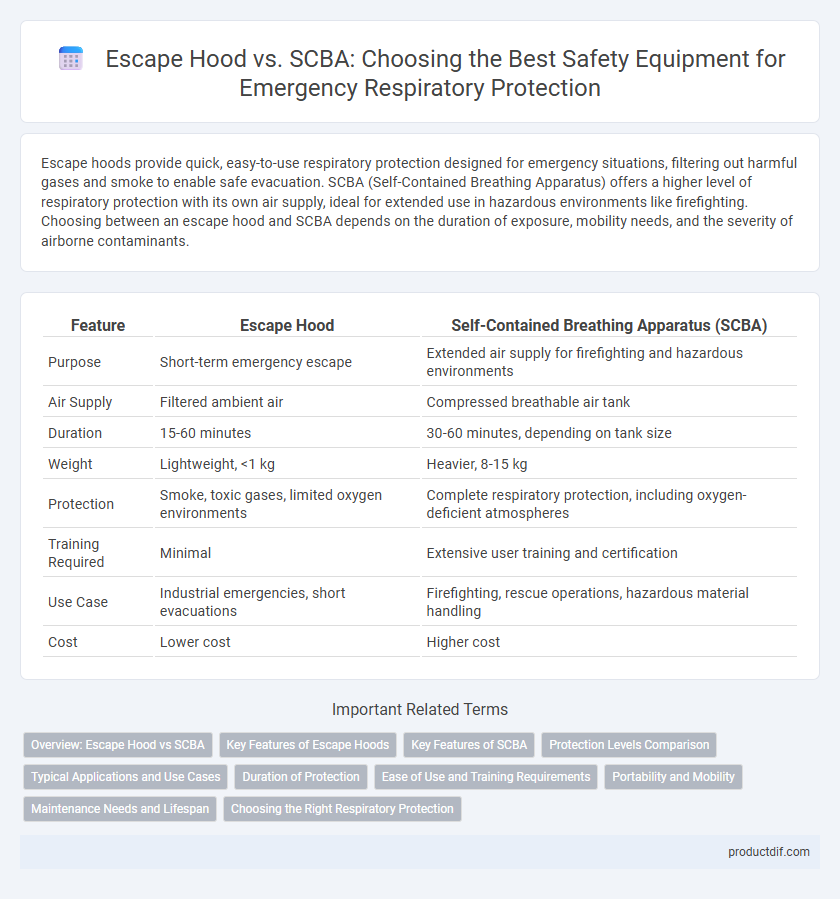Escape hoods provide quick, easy-to-use respiratory protection designed for emergency situations, filtering out harmful gases and smoke to enable safe evacuation. SCBA (Self-Contained Breathing Apparatus) offers a higher level of respiratory protection with its own air supply, ideal for extended use in hazardous environments like firefighting. Choosing between an escape hood and SCBA depends on the duration of exposure, mobility needs, and the severity of airborne contaminants.
Table of Comparison
| Feature | Escape Hood | Self-Contained Breathing Apparatus (SCBA) |
|---|---|---|
| Purpose | Short-term emergency escape | Extended air supply for firefighting and hazardous environments |
| Air Supply | Filtered ambient air | Compressed breathable air tank |
| Duration | 15-60 minutes | 30-60 minutes, depending on tank size |
| Weight | Lightweight, <1 kg | Heavier, 8-15 kg |
| Protection | Smoke, toxic gases, limited oxygen environments | Complete respiratory protection, including oxygen-deficient atmospheres |
| Training Required | Minimal | Extensive user training and certification |
| Use Case | Industrial emergencies, short evacuations | Firefighting, rescue operations, hazardous material handling |
| Cost | Lower cost | Higher cost |
Overview: Escape Hood vs SCBA
Escape hoods provide a lightweight, portable means of protection against smoke and toxic gases, typically designed for short-term use during emergency evacuations. Self-Contained Breathing Apparatus (SCBA) offers a more robust respiratory solution with an independent air supply, commonly used by firefighters and hazardous materials personnel for extended operations in highly toxic or oxygen-deficient environments. The primary distinction lies in escape hoods being ideal for temporary escape, while SCBAs support sustained breathable air supply for prolonged and high-risk interventions.
Key Features of Escape Hoods
Escape hoods provide lightweight, portable respiratory protection designed to filter out toxic gases and smoke, allowing safe egress during emergencies. They typically feature a compact design, easy donning in seconds, and a clear visor for unobstructed vision. Unlike SCBAs, escape hoods do not supply oxygen but rely on filtration, making them ideal for short-term escape rather than extended use or hazardous environments with low oxygen levels.
Key Features of SCBA
Self-Contained Breathing Apparatus (SCBA) offers high-level respiratory protection by providing a continuous supply of breathable air from a high-pressure tank, enabling extended use in hazardous environments. Key features include a full-face mask for complete respiratory and eye protection, a pressure regulator for steady airflow, and a robust harness system for secure and comfortable wear. SCBAs are essential for firefighters, industrial workers, and emergency responders requiring reliable protection against toxic gases, smoke, and oxygen-deficient atmospheres.
Protection Levels Comparison
Escape hoods offer limited respiratory protection designed for short-term escape from smoke or toxic environments, filtering particulates and certain gases but not supplying oxygen. Self-Contained Breathing Apparatus (SCBA) provides a higher protection level by delivering independent, breathable air, enabling prolonged operation in oxygen-deficient or highly toxic atmospheres. SCBA systems are essential for firefighters and industrial workers exposed to hazardous environments, while escape hoods serve as emergency backup gear for brief evacuation.
Typical Applications and Use Cases
Escape hoods are designed primarily for short-term use in emergency evacuations, protecting users from smoke, toxic gases, and airborne particulates during rapid escape from hazardous environments such as fires or chemical spills. Self-Contained Breathing Apparatuses (SCBA) are used in more intensive, prolonged operations like firefighting, confined space entry, and hazardous material handling, providing a continuous supply of breathable air in oxygen-deficient or highly contaminated atmospheres. While escape hoods offer quick deployment and ease of use for non-professionals, SCBAs require training and maintenance but deliver superior respiratory protection for extended rescue and intervention tasks.
Duration of Protection
Escape hoods typically provide short-duration protection, ranging from 10 to 60 minutes, designed for rapid evacuation in smoke or toxic environments. SCBA (Self-Contained Breathing Apparatus) offers extended air supply, often lasting 30 to 60 minutes or longer depending on cylinder capacity, suitable for prolonged firefighting or hazardous material response. The choice between escape hoods and SCBA depends on the required duration of protection and the specific emergency scenario.
Ease of Use and Training Requirements
Escape hoods offer greater ease of use compared to SCBA (Self-Contained Breathing Apparatus) due to their simple donning procedures and minimal training requirements, making them suitable for emergency evacuations. SCBA units require extensive training and regular practice to ensure proper use and maintenance, as they are designed for prolonged respiratory protection in hazardous environments. The streamlined design of escape hoods allows for quick deployment, while SCBA provides superior protection but demands higher user proficiency.
Portability and Mobility
Escape hoods offer superior portability and lightweight design, allowing users to quickly don them and move through confined spaces during emergencies. Self-Contained Breathing Apparatus (SCBA) provides comprehensive respiratory protection but is bulkier and heavier, often limiting mobility in tight or complex environments. For rapid evacuation and ease of movement, escape hoods are more practical, while SCBAs are better suited for extended operations requiring robust air supply.
Maintenance Needs and Lifespan
Escape hoods typically require minimal maintenance, often consisting of periodic inspections and replacement after use or expiration, with a lifespan ranging from 3 to 5 years depending on manufacturer guidelines. Self-contained breathing apparatus (SCBA) demands rigorous and frequent maintenance, including regular cylinder refilling, component servicing, and functional testing, contributing to a longer operational lifespan that can extend beyond 10 years with proper care. The contrasting maintenance schedules and durability make escape hoods suitable for short-term emergency use, while SCBAs are preferred for repeated, long-term respiratory protection in hazardous environments.
Choosing the Right Respiratory Protection
Selecting the right respiratory protection depends on the specific hazards and environment encountered. Escape hoods provide emergency protection against smoke, toxic gases, and oxygen-deficient atmospheres, designed for quick evacuation and short-term use. Self-contained breathing apparatus (SCBA) offers higher-level respiratory defense with a dedicated air supply, suitable for extended operations in hazardous or oxygen-deficient conditions where prolonged exposure occurs.
Escape hood vs SCBA Infographic

 productdif.com
productdif.com